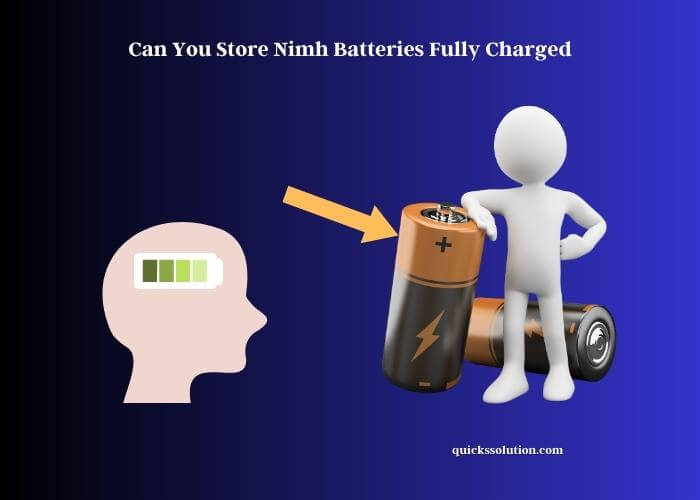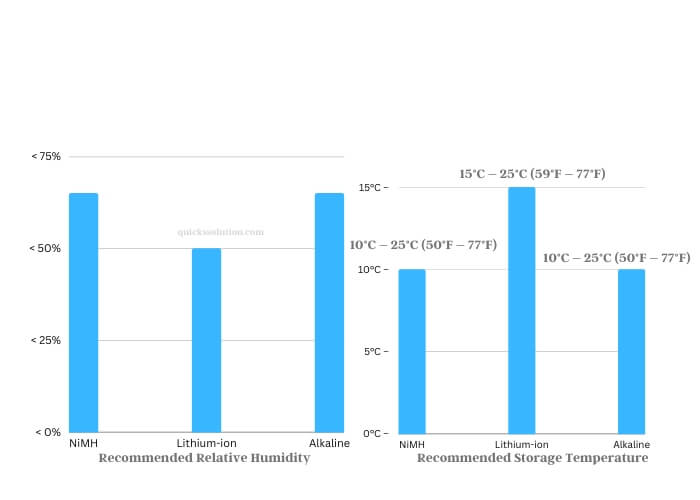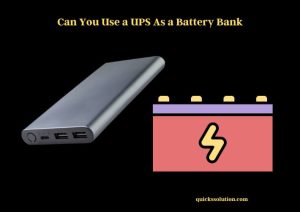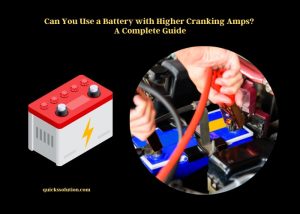Published on: September 3, 2023
Written by John Stevens / Fact-checked by Hashim Manna
Yes, you can store NiMH batteries fully charged, but it is recommended to store them at around 80% charge if you do not plan to use them for several months or longer.
Storing NiMH batteries properly is crucial for maintaining their performance and lifespan. NiMH stands for Nickel-Metal Hydride, a type of rechargeable battery commonly used in various electronic devices and RC (remote control) vehicles. It is recommended to store NiMH batteries at around 80% charge, as this level is found to be optimal for preserving their capacity over time. Avoid storing NiMH batteries with 0% power, as this can lead to irreversible damage.
The full charge voltage of a NiMH battery typically ranges from 1.4 to 1.6 volts per cell. It is essential to monitor the voltage and not overcharge the batteries, as overcharging can lead to reduced battery life. Unused NiMH batteries can last for several years if stored correctly, but their capacity will gradually decrease over time. Generally, batteries stored in a cool, dry place at the recommended voltage will last longer in storage.

While similar in some aspects, lithium-ion batteries have different storage requirements. It is not advisable to store lithium-ion batteries fully charged or completely empty. Instead, it is recommended to store them at around 50% charge to maximize their lifespan.
Remember to check your NiMH and lithium-ion batteries’ charge level before storing them for an extended period. Proper storage will help prolong the life of your rechargeable batteries and ensure they are ready for use when you need them.
For more detailed information on this topic, please read the article below.
Can You Store NiMH Batteries Fully Charged?
Overview of NiMH Batteries
Definition and Common Uses
NiMH stands for Nickel-Metal Hydride. NiMH batteries are a type of rechargeable battery commonly used in various electronic devices, such as digital cameras, cordless phones, and RC vehicles. They are popular due to their higher energy density compared to older nickel-cadmium (NiCd) batteries and because they do not suffer from the “memory effect.”
Comparison with Other Battery Types
Table 1 below compares NiMH batteries with lithium-ion and alkaline batteries in terms of voltage, capacity, and shelf life. NiMH batteries typically have a nominal voltage of 1.2 volts per cell, which is lower than lithium-ion and alkaline batteries. However, they offer higher capacity and a reasonable shelf life, making them a suitable choice for many applications.
| Battery Type | Nominal Voltage (per cell) | Typical Capacity (mAh) | Shelf Life |
| NiMH | 1.2V | 600-2700 | 3-5 years |
| Lithium-ion | 3.7V | 1500-3000 | 2-3 years |
| Alkaline | 1.5V | 1800-3000 | 5-10 years |
The Importance of Proper Battery Storage
Effects of Improper Storage
Improper storage of batteries can lead to a decrease in capacity, reduced performance, and, in extreme cases, damage to the battery. For example, storing batteries at high temperatures or in a humid environment can cause internal corrosion, leading to reduced capacity and battery failure.
Key Factors for Optimal Storage
Table 2 shows the optimal storage conditions for different battery types. For NiMH batteries, it is best to store them in a cool, dry place with a stable temperature. The recommended storage temperature for NiMH batteries is between 10°C and 25°C (50°F and 77°F) with a relative humidity of less than 65%.
| Battery Type | Recommended Storage Temperature | Recommended Relative Humidity |
| NiMH | 10°C – 25°C (50°F – 77°F) | < 65% |
| Lithium-ion | 15°C – 25°C (59°F – 77°F) | < 50% |
| Alkaline | 10°C – 25°C (50°F – 77°F) | < 65% |

The Ideal Charge Level for Storing NiMH Batteries
Risks of Overcharging or Completely Draining
Overcharging or completely draining a NiMH battery can cause irreversible damage. Overcharging can lead to the formation of gas inside the battery, causing it to swell or leak. Completely draining the battery, on the other hand, can cause the formation of a crystalline structure on the battery’s electrodes, known as dendrites, which can lead to a short circuit.
Recommended Charge Level for Long-term Storage
The recommended charge level for storing NiMH batteries is around 80%. This charge level is found to be optimal for preserving the battery’s capacity over time. It is not advisable to store NiMH batteries with 0% power or fully charged as it can lead to reduced battery life.
Tips for Storing NiMH RC Batteries
Specifics for RC Vehicle Batteries
RC vehicle batteries often require special attention due to their higher energy demands and discharge rates. For RC vehicle NiMH batteries, it is recommended to discharge them to about 50% of their capacity before storing them for an extended period. This will help to minimize the risk of dendrite formation and preserve the battery’s capacity.
Maximizing Performance and Lifespan
To maximize the performance and lifespan of your NiMH RC batteries, it is also recommended to cycle them at least once every 3-6 months. Cycling involves fully discharging the battery and then recharging it to its full capacity. This process helps to keep the battery’s internal components active and maintain its performance over time.
How Temperature and Humidity Affect NiMH Batteries
Temperature and Its Impact on Battery Life
The storage temperature plays a crucial role in determining the lifespan of NiMH batteries. Storing batteries at high temperatures can accelerate the self-discharge rate and lead to a reduction in overall capacity. On the other hand, storing batteries at very low temperatures can cause the electrolyte inside the battery to freeze, leading to permanent damage.
Humidity and Its Effect on Battery Performance
Humidity is another critical factor that affects the performance of NiMH batteries. High humidity levels can cause internal corrosion, leading to reduced capacity and battery failure. It is essential to store NiMH batteries in a dry place with a relative humidity of less than 65% to ensure their optimal performance and longevity.
Longevity of NiMH Batteries in Storage
How Long Do Unused NiMH Batteries Last?
Unused NiMH batteries can last for several years if stored correctly. However, their capacity will gradually decrease over time. Generally, NiMH batteries lose about 20% of their capacity each year when stored at room temperature. Therefore, it is essential to check the charge level of the batteries periodically and recharge them if necessary.
Factors Affecting NiMH Battery Shelf Life
Several factors affect the shelf life of NiMH batteries, including the storage temperature, humidity level, and charge state. Storing batteries at a lower temperature and lower humidity level can help to prolong their shelf life. Additionally, it is recommended to store NiMH batteries at around 80% charge to maximize their lifespan.
Storing Lithium-ion Batteries: A Comparison
Differences in Storage Requirements
Lithium-ion batteries have different storage requirements compared to NiMH batteries. For lithium-ion batteries, it is not advisable to store them fully charged or completely empty. Instead, it is recommended to store them at around 50% charge to maximize their lifespan.
Charge Level Recommendations for Lithium-ion Batteries
Storing lithium-ion batteries at a 50% charge level helps to minimize the stress on the battery and reduce the risk of capacity loss. It is also essential to store lithium-ion batteries in a cool, dry place with a stable temperature to ensure their optimal performance and longevity.
NiMH Battery Storage Calculator
To help you determine the recommended storage charge level for your NiMH batteries, we have created a simple calculator. You can input parameters such as the current charge level, storage duration, and temperature, and the calculator will provide you with the recommended storage charge level and tips for optimal storage.
NiMH Battery Storage Calculator
FAQs
Can You Store NiMH Batteries Fully Charged?
Storing NiMH batteries fully charged is not recommended. It is advised to store NiMH batteries at around 80% of their capacity. This charge level is optimal for preserving the battery’s capacity over time. Storing them fully charged can lead to reduced battery life.
What Is the Full Charge Voltage of a NiMH Cell?
The full charge voltage of a NiMH cell is approximately 1.4 to 1.6 volts per cell. However, the nominal voltage, or the voltage that a cell operates at under load most of the time, is 1.2 volts for a NiMH battery.
Does Storage Temperature Affect NiMH Battery Life?
Yes, the storage temperature affects the life of NiMH batteries. Storing batteries at high temperatures can accelerate the self-discharge rate and lead to a reduction in overall capacity. It is best to store them in a cool, dry place with a stable temperature between 10°C and 25°C (50°F and 77°F).
How Long Do Alkaline Batteries Last in Storage?
Alkaline batteries have a longer shelf life compared to NiMH batteries. They can last between 5 to 10 years in storage. However, their capacity may gradually decrease over time, so it is advisable to check the charge level periodically and replace them if necessary.
What Is the Shelf Life of NiMH Batteries?
The shelf life of NiMH batteries is typically 3 to 5 years. NiMH batteries lose about 20% of their capacity each year when stored at room temperature. Therefore, it is advisable to check the charge level periodically and recharge them if necessary.
Are There Any Special Care Instructions for NiMH RC Batteries?
For RC vehicle NiMH batteries, it is recommended to discharge them to about 50% of their capacity before storing them for an extended period. This will help to minimize the risk of dendrite formation and preserve the battery’s capacity. Also, it is recommended to cycle them at least once every 3-6 months.
How to Store NiMH RC Batteries?
To store NiMH RC batteries, it is recommended to discharge them to about 50% of their capacity before storing them for an extended period. Store the batteries in a cool, dry place with a stable temperature. Also, cycle the batteries at least once every 3-6 months to maintain their performance over time.
Summary
Proper storage of NiMH batteries is crucial to ensure their optimal performance and longevity. The recommended charge level for storing NiMH batteries is around 80%. This charge level is found to be optimal for preserving the battery’s capacity over time. It is also essential to store NiMH batteries in a cool, dry place with a stable temperature and a relative humidity of less than 65%. Additionally, it is recommended to cycle NiMH RC batteries at least once every 3-6 months to maintain their performance over time.
If you are unsure about the recommended storage charge level for your NiMH batteries, you can use the NiMH battery storage calculator provided above for personalized recommendations. This calculator will help you determine the recommended storage charge level based on your current charge level, storage duration, and temperature.
You May Also Like:
- Why Isn’t My Samsung Phone Charging When Plugged In? Solutions and Insights
- Cranking Amps Diminishing in Batteries: Causes and Consequences
- Why Your Dodge Charger is Making Noise When Accelerating: An In-Depth Analysis
- Silverado Horn Not Working When Locking? How to Diagnose and Fix the Problem
- Resolving 2017 Jeep Grand Cherokee Auxiliary Battery Not Charging
- Can I Use a 3000mAh Battery Instead of 2000mAh?




